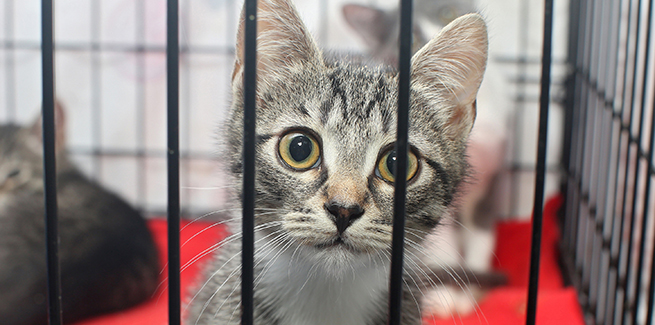Study: UV air-disinfection systems can reduce upper respiratory infections in cats

A recent field trial conducted at the Arizona Humane Society in Phoenix, Arizona, explored the potential impact of using ultraviolet (UV) germicidal irradiation air-disinfection systems in animal shelters. Upper respiratory infections (URIs) in cats living in the facility’s kitten nursery decreased by nearly 90% after these systems were installed.
The study, “Effect of ultraviolet germicidal irradiation of the air on the incidence of upper respiratory tract infections in kittens in a nursery,” was published this month in the Journal of the American Veterinary Medical Association.
Two UV germicidal irradiation systems were installed in the shelter’s kitten nursery—one within the heating, ventilation, and air conditioning system itself, and the other attached to the ceiling. Air passes through the UV units, where UVC* lights eliminate and kill airborne molds, viruses, and bacteria.
Researchers collected data on the number of kittens diagnosed with a URI in 2016, when no UV systems were in place, and compared it to the number of kittens diagnosed with a URI in 2018, when the UV systems were in regular use.
The overall incidence of URIs in 2016 was 12.4 cases/100 kitten admissions. In 2018, that number fell to 1.6 cases/100 kitten admissions, a decrease of 87.1%.
Based on their findings, the authors write that, “Airborne transmission of feline respiratory pathogens may be more important than has been previously recognized. Ultraviolet germicidal irradiation systems that disinfect the air may be an effective adjunct to standard infection prevention and control protocols in reducing the risk of the transmission of respiratory pathogens among kittens in nurseries and shelters.”
NEWStat contacted corresponding author Robyn Jaynes, DVM, director of Maricopa County Animal Care and Control in Phoenix, Arizona, and former employee of the Arizona Humane Society location where the study was done, to find out more.
NEWStat: What inspired you to do the study in an animal shelter?
Robyn Jaynes: My background prior to working in animal shelters included overseeing the safety of pets in boarding facilities. In that environment, kennel cough and canine influenza, among other respiratory infections, is something that facilities continue to experience, even with strict vaccination guidelines. The addition of UV air disinfection seemed to help, although a full study [wasn’t done]. Working in the shelter . . . seemed like a good time to test the impact in a more formal way.
NEWStat: How common are URIs in animal shelters compared to animal hospitals?
RJ: [They’re] much more common in animal shelters due to the longer time a pet is in the facility, the often-unknown background or vaccination status of the pets in the facility, and the stress associated with animal shelters.
NEWStat: Your study notes that airborne transmission of viral and bacterial pathogens has not been adequately addressed in disinfection protocols in animal facilities. Why do you think that is?
RJ: I suspect that [the] focus has been on surface disinfection, vaccinations, and reducing stress through proper housing. Ultimately, all of these items, in addition to air cleaning, are critical in my opinion. One item alone will not solve disease transmission.
NEWStat: How has your shelter typically handled cases of URI up until now?
RJ: Strict surface cleaning, changing of personal protective equipment between groups of animals, and vaccinations.
NEWStat: Would a similar UV-disinfectant system make sense in a regular animal hospital?
RJ: It would, especially if the hospital boarded pets overnight for treatment of illness or just for general boarding.
While Jaynes says more research is needed, the early data is encouraging, and ultraviolet germicidal irradiation systems could become a standard safety feature in future animal hospital design.
Photo credit: © Masha Rasputina/iStock/Getty Images Plus via Getty Images Plus



